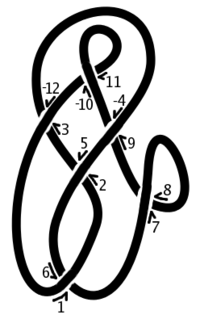Dowker notation

In the mathematical field of knot theory, the Dowker notation, also called the Dowker–Thistlethwaite notation or code, for a knot is a sequence of even integers. The notation is named after Clifford Hugh Dowker and Morwen Thistlethwaite, who refined a notation originally due to Peter Guthrie Tait. To generate the Dowker notation, traverse the knot using an arbitrary starting point and direction. Label each of the n crossings with the numbers 1, ..., 2n in order of traversal (each crossing is visited and labelled twice), with the following modification: if the label is an even number and the strand followed crosses over at the crossing, then change the sign on the label to be a negative. When finished, each crossing will be labelled a pair of integers, one even and one odd. The Dowker notation is the sequence of even integer labels associated with the labels 1, 3, ..., 2n − 1 in turn.
For example, a knot diagram may have crossings labelled with the pairs (1, 6) (3, −12) (5, 2) (7, 8) (9, −4) and (11, −10). The Dowker notation for this labelling is the sequence: 6 −12 2 8 −4 −10.
A knot can be recovered from a Dowker sequence, but the recovered knot may differ from the original by being a reflection or (more generally) by having any connected sum component reflected in the line between its entry/exit points – the Dowker notation is unchanged by these reflections. Knots tabulations typically consider only prime knots and disregard chirality, so this ambiguity does not affect the tabulation.
The ménage problem, posed by Tait, concerns counting the number of different number sequences possible in this notation.
See also
Further reading
- Adams, Colin Conrad (2001). The Knot Book: An Elementary Introduction to the Mathematical Theory of Knots. Providence, R.I.: American Mathematical Soc. ISBN 978-0-8218-3678-1.
- Dowker, C. H.; Morwen B. Thistlethwaite (1983). "Classification of knot projections". Topology and its Applications. 16 (1): 19–31. doi:10.1016/0166-8641(83)90004-4..